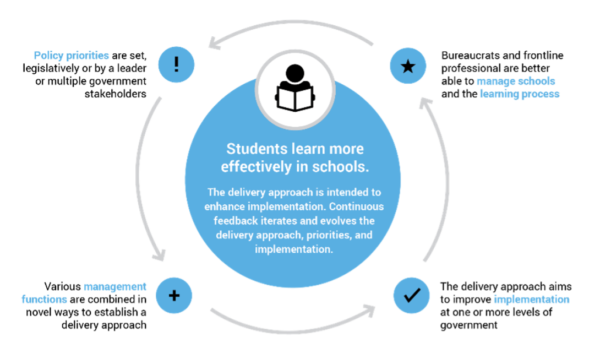How can delivery approaches support governments now and in the future?
With the COVID-19 pandemic continuing to create pressing challenges for education delivery and threatening to cut education sector budgets, understanding how governments can implement policies and interventions effectively and achieve results in education is more crucial than ever.
The Save Our Future White Paper calls for action to address this gap in ensuring efficacy and equity in spending. It highlights that while there is a growing understanding of what interventions do and do not have impact on learning, how that implementation is achieved is just as important as design of the intervention itself.
Governments are hungry for this expertise, but the science of successfully implementing and scaling education reforms for learning is still nascent. Similarly, development partners are grappling with how to improve in-country coordination with governments, as a key constraint to delivering results and ensuring that the array of stakeholders which participate in the delivery of an education sector plan are aligned in strategic ways.
The Education Commission’s DeliverEd Initiative is working to fill this knowledge gap and inform policymakers and practitioners on how to deliver their reforms successfully and achieve results. In DeliverEd’s policy brief The Challenge of Delivering for Learning we explore what a delivery approach is and how these approaches can impact government execution of reforms.
A delivery approach is an institutional unit or process used by governments to improve their performance when delivering services and implementing policy. The mechanisms leveraged by delivery approaches are often not new to a bureaucracy – they are things that bureaucracies do every day. But delivery approaches bundle these mechanisms, like target setting, evaluating, or problem-solving, together in a novel way in that context. Bundling project implementation and monitoring teams together or changing how they collaborate, for example, can connect project planners more closely to those who are assessing progress, enabling more rapid resolution of problems blocking implementation.
Put simply, these approaches are used as a way for governments to get things done and for leaders to ensure their commitments to citizens result in real transformation.

While delivery approaches can vary in design and impact, they aim to improve coordination and connections across government actors or with collaborating stakeholders. This can happen at the center – better connecting Ministries of Finance or civil service administrations and education decision-makers, for example – at sub-national levels, improving how district or regional officials work with the center – or more locally, with schools and school leaders.
Through a delivery approach, for example, health and education ministry staff may begin to coordinate and collaborate in more effective ways, enabling more timely and complete implementation of school-based nutrition or health programs – or post-COVID back-to-school programming.
This process of engagement is not necessarily top-down or one-directional, and our definition of a delivery approach emphasizes that this feedback can occur continuously within these levels. Many delivery approaches emphasize problem-solving, communication, and collaboration or aim to empower frontline workers to operate more effectively. Because of this, the very process of carrying out a delivery approach means that it could also impact what priorities are set and better inform policymakers on what their agendas should be.
DeliverEd is identifying and mapping delivery units worldwide to catalog the range of approaches and how they improve implementation. We will soon be posting this library of delivery approaches on a global map to the Education Commission website. Governments are developing creative solutions to overcome coordination and implementation challenges worldwide, and we encourage others to share information on delivery initiatives they are participating in to capture the diversity of available solutions.
For more details on our definition of delivery approaches and more examples of these approaches in education, read our policy brief The Challenge of Delivering for Learning.

